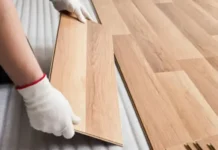You’ve finally finished your deck and can’t wait to see it in its completed glory. But before reaching the endpoint, there are a few things that need to be done to ensure a successful outcome. We’ll cover 10 tips for staining your deck so you don’t experience any surprises. You can also see deck staining here.
Tip #1: Don’t Do the Project on a Hot Day – Go to the Beach Instead
Do not do the project on a hot day if possible. It is best to wait until temperatures are in the low 70s and there isn’t any chance of rain or thunderstorms for at least 24 hours after you’ve applied the stain. If the temperatures are too far gone, make sure to reschedule your project date.
Tip #2: Don’t Forget the Brush – It Will Save You Time and Money!
Make sure you have a high-quality paintbrush available for your stain project, as it will save you both time and money in the end. A good bristle brush can help ensure that stains are applied evenly and without brush strokes, which can lead to a much better-looking finished product.
Tip #3: Keep the Little Ones Out of the Way
Make sure that you keep little ones out of the way when staining a deck. If possible, try to schedule their naptime or have someone take them for a walk so they aren’t underfoot while you are working on this project.
Tip #4: Watch a Tutorial Video Before You Stain
Before you begin staining your deck, it is a good idea to watch a video of the process so that you have a visual reference. This can help ensure that no steps are missed and will result in an even better-finished product!
Tip #5: Start With the Railing
Before staining your deck boards, it’s a good idea to first stain wood railings. By doing so, you will avoid getting stains on other parts of your project that are more difficult to replace or repair after they have been stained.
Also, make sure to apply two thin coats over bare wood instead of one thick coat for better coverage and less waste.
Tip #6: Clean Your Deck and Do a Test Area First
Make sure to clean your deck before applying any stains. Use a pressure washer and/or power scrub brush to remove dirt, grime, and moss from the surface of the wood. Once you’ve cleaned it thoroughly, make sure that there is no debris on it either by checking with a broom or sweeping up loose particles after cleaning. Then apply a test area so you can see how the stain will look before applying it to all of your deck boards.
Tip #7: Keep the Sprayer Moving to Avoid Drips and Runs
When applying a stain with a sprayer, make sure to keep the nozzle moving constantly. This will help you ensure that no drips or runs are left on your deck boards and it’s also necessary for even coverage! It is recommended to use an HVLP (high volume low pressure) type of gun for best results.
Tip #8: Keep the Stain Off of Metal
When staining your deck, it is a good idea to keep stain off of metal surfaces such as railings and posts. This can be done by applying masking tape or plastic wrap in these areas before you start staining so that stains don’t get onto them during application.
Don’t let the stains sit on your deck for more than a few days or they will begin to peel and flake off in large pieces! This is another reason you should thin out your stain with paint thinner so that it penetrates deeper into the wood, preventing peeling later.
Tip #9: Keep a Wet Edge
When staining your deck, it is vital to keep a wet edge when moving the brush across the wood paneling (or sprayer nozzle over the railing and floorboards). This will help you avoid having any stain dry in place before you’ve had time to move on to the next area! The best way to do this is to keep a container of thinner nearby and dip the brush in it every few inches while working.
Tip #10: Finish Off Your Deck With a Sealant or Matte Finish to Protect it From Stains and Debris
It is recommended to apply a sealant or matte finish after you’ve stained your deck. This will help protect the wood from stains and debris so that it stays looking nice for longer! It’s also important not to use any oil-based products on your deck because they can cause health issues and discoloration over time.



































































